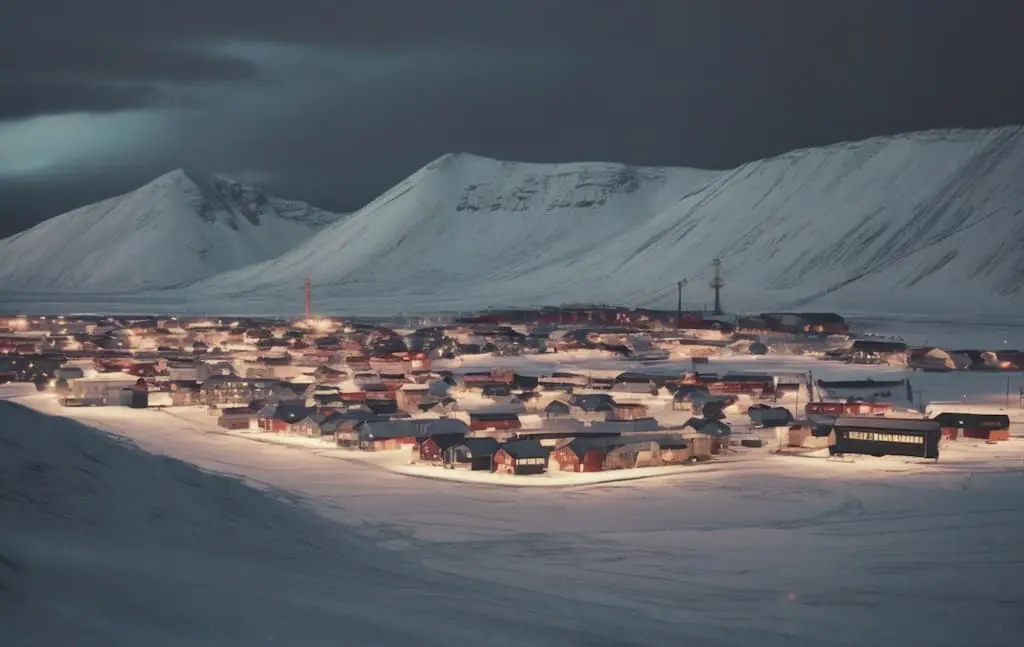In a remote corner of the world, in the town of Longyearbyen, a peculiar norm defies the conventional boundaries of life and death. But this is not a sinister or macabre story. It’s an anecdote that emanates from the arctic cold and is intertwined with the wonders and challenges of extreme nature. Longyearbyen, a settlement nestled in the Norwegian archipelago of Svalbard, lies just beyond the confines of the North Pole.
SEE ALSO: Places on Earth that seem to be from another planet

It is a place where the inhabitants live immersed in a perpetual winter. Where days turn into weeks and months without seeing the warm glow of the Sun. But it’s not sadness that defines this community, but the breathtaking beauty of the Northern Lights that paint their night skies with ethereal colors. In this peculiar scenario, a singular and striking rule emerges as a response to the tenacity of the unforgiving climate.
Approximately 2,000 people live in Longyearbyen, all subject to an extraordinary rule: it is forbidden to die. However, this is not a capricious command, but a measure emanating from the peculiarity of its icy environment.
The prohibition of death in Longyearbyen.
In 1950, the local government made a bold decision. Faced with the discovery that the exhumed bodies of victims of the 1918 flu pandemic still contained active samples of the virus after more than eight decades, they decided that Longyearbyen would prevent death from becoming a persistent threat as much as possible. The reason for this initiative lay in the cold climate and its impact on the decomposition process.
The frigid nature of the region acted as a kind of natural preservative, preserving the integrity of the corpses in an uncommon state. However, the authorities could not prevent people from dying, and the solution was to modify the handling of the corpses. That is why, when someone is on the verge of death, they are transferred to the mainland for their eternal rest.
The only exception to this rule is cremation, a practice that removes the obstacle of decomposition and allows the remains of the deceased to remain on the Nordic island. Longyearbyen is a place of contrasts. The rarity of funerals is combined with the rarity of births. Since mothers choose to travel to the continent in search of more comfortable conditions to give birth. Despite these unique challenges, the community subsists in harmony, united by its extraordinary environment and the shared experiences it offers.

Why forbid death?
Science sheds light on the intriguing phenomenon of corpse preservation happening in Longyearbyen. Intense cold provides an environment conducive to the preservation of viruses and other pathogens. At low temperatures, viruses maintain their stability and infectivity for longer. The slowness of chemical reactions and biological degradation in the cold contribute to this preservation. Viral particles remain intact and functional under these extreme conditions.
In addition, ultraviolet radiation from the Sun, which would normally harm viruses, is attenuated in cold regions with limited sun exposure. This allows viruses to persist for longer periods. Finally, it is important to note that influenza viruses can find more efficient forms of transmission in cold environments with reduced humidity levels, factors that increase their chances of survival and subsequent spread.
Other attempts to prohibit death.
Despite its uniqueness, Longyearbyen is not the only city in its attempt to defy the inevitability of death. Throughout history, some places sought to implement unconventional measures to address particular problems. These singular actions, although surprising, left a curious mark on the chronology of municipal regulations.
An emblematic case took place in 2012 in Falciano del Massico, a picturesque Italian town. The then-mayor set out to carry out an initiative that sought, in essence, to ban the inevitable act of dying. However, this move was met with a palpable irony: the city lacked a designated place for the remains. Despite this insurmountable obstacle, the order was not without disobedience, defying logic and reality itself.
The concept of prohibiting death expanded beyond Italian borders. Towns such as Lanjarón in Spain and Sarpourenx in France also joined this unique legislative trend. However, these initiatives shared a common fate: the lack of success in their implementation. The inherent impossibility of controlling a natural and universal process stood as an inescapable reminder, highlighting the disconnect between the purpose of these laws and tangible reality.
In 2005, the Brazilian landscape was tinged with a similar extravagance when the mayor of Biritiba-Mirim in the state of São Paulo tried to restrict the act of dying. This measure stemmed from the saturation of the local cemetery. The project proposed fines for families who did not comply with this peculiar prohibition, but it was blocked by the City Council, which vetoed this unique proposal from the local executive. This controversy revealed the complexity of regulating natural events and the need for more pragmatic solutions.
These episodes of governments attempting to outlaw death, while unusual, also offer a fascinating perspective on the relationship between normative power and the immutable limitations of human life. Although in most cases these measures proved ineffective and paradoxical, their memory endures as an example of the human quest to control the uncontrollable.



Comments